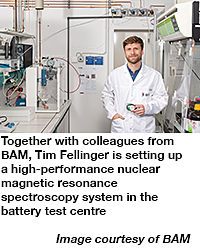New research infrastructure strengthens battery cell production in Germany
01/11/2022
Research into innovative battery materials plays a decisive role in the development of competitive battery cell production in Germany. The Bundesanstalt für Materialforschung und -prüfung (BAM) is now setting up a high-performance nuclear magnetic resonance spectroscopy facility at its battery test centre. It will support companies, start-ups and research institutions throughout Germany to facilitate innovations and their transfer to industrial application. 
According to the German federal government’s plans, Germany aims to become the leading battery cell producer in Europe. Numerous gigafactories throughout Germany are already being planned. In order to gain advantages in the global competition in the long term, it will be particularly important for them to produce battery cells that are durable, powerful, cost efficient and safe.
“In order to meet these major challenges, companies are dependent on rapid access to modern analytical techniques and current research data,” said Tim Fellinger, a specialist for energy materials at BAM’s Battery Test Centre.
For the development of powerful and safe batteries, it is crucial to thoroughly characterise the materials used for anodes and cathodes and their behaviour in the storage process.
Established methods such as X-ray crystallography are increasingly reaching their limits because the battery components are becoming increasingly complex.
In addition to measurements in large particle accelerators (synchrotrons), nuclear magnetic resonance spectroscopy is gaining traction. It allows for an in-depth investigation of lithium batteries, as well as the characterisation of emerging components, such as for sodium-based batteries.
“Setting up such an infrastructure and operating it with respective experts would be very costly and not feasible for many companies in the field of battery cell production,” said Tim.
BAM, as a federal research institution, is setting up a state-of-the-art nuclear magnetic resonance spectroscopy facility in its battery test centre. The project is funded by the Federal Ministry of Education and Research as part of the umbrella programme ‘Battery Research Factory’, with around €2 million (approximately £1.74 million).
“In the future, we will be able to offer companies, as well as the scientific community, an outstanding infrastructure for the analysis of battery materials and jointly drive innovations forward,” said Tim. “The infrastructure will be readily available, mediated by the existing competence clusters in the German battery research landscape. It should encourage companies and start-ups to test new and sustainable battery materials beyond the current lithium-ion technology, which can drive innovation in battery research in Germany.”
Tim and his team will also use the new nuclear magnetic resonance spectroscopy for their own research. They are investigating sustainable sodium-ion batteries, which are considered an alternative to lithium batteries, as well as anodes made of so-called hard carbons, which are considered promising energy storage materials.